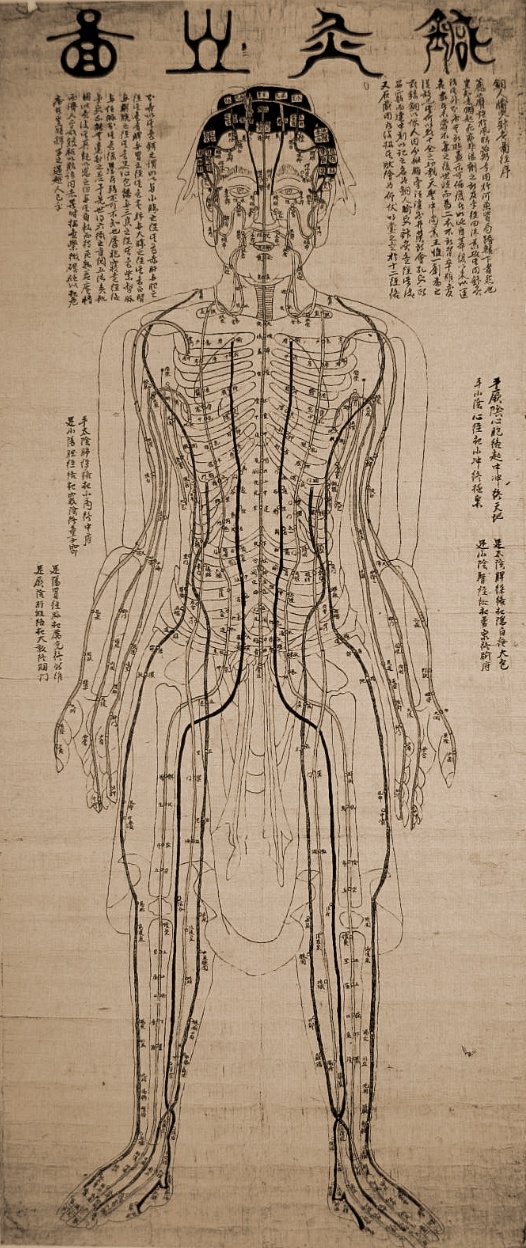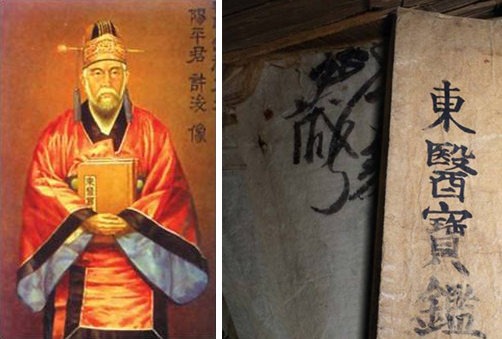indicator
Traditional Korean Medicine – the ancient art and science of healing the body
Originating centuries ago, traditional Korean medicine is an ancient practice of healing that not just cures an illness or ailment, but treats the entire body holistically.

<A doctor of traditional Korean medicine applies acupuncture needles to a patient.>
Needles, tools of fear and healing
When a small child whines, Korean grandfathers need only say, "If you keep whining, the doctor will put a needle in you!" to put a stop to it immediately. In fact the mere thought of not just one but scores of acupuncture needles being pricked into bare skin evokes great fear in many, not just young children – evidence of how acupuncture is deeply entrenched in the daily lives of Koreans. Called "chim" in Korean, acupuncture is one of several treatment methods of traditional Korean medicine.

<A diagram of acupuncture points on the human body at the National Museum of Korea.>
Many people's lives have been changed by acupuncture, including Raimund Royer's. While on a backpacking trip in Korea in 1987 as a young man, the Austrian injured his ankle, requiring him to receive acupuncture treatment at a traditional Korean medical clinic. Royer recalls his terror upon seeing the needles and watching the doctor as he stuck them in parts of his body that seemed completely unrelated to his hurt ankle. Unable to communicate in Korean, the Austrian's patience was severely tried. However, after the application of a few needles and a few cautious steps on both feet, the pain disappeared. Shocked by the experience, Royer made the decision to move to Korea and study traditional Korean medicine. After receiving his doctorate, he began his career as a doctor of traditional Korean medicine.

<Raimund Royer is currently working in Korea as a doctor of traditional Korean medicine.>
Traditional Korean medicine: A compilation of Eastern philosophy
Traditional Korean medicine, which has been in existence since antiquity, is based on Eastern philosophy and was developed through medical exchanges between countries that use Chinese characters, such as China and Japan. In traditional Korean medicine, the human body is viewed as a miniature universe. The principles, treatment methods and medication for the physiology and pathology of the body are explained by the yin-yang and five elements theory, which is based on the concept of yin and yang as the operating principle of the universe. Therefore, illnesses are not treated and cured locally; rather, they are regarded as the result of an abnormality or change to the entire body and are, therefore, treated holistically.

<The "Taegukdo" (Diagram of the Great Supreme) of Yi Hwang's "Ten Diagrams on Sage Learning." This diagram explains the human body as a miniature version of the universe.>

<Herbal medicine prescribed at a Korean traditional medical clinic.>
Traditional Korean medicine does not attempt to learn about the body by dissection, experimentation or analysis, but instead observes natural bodily functions as they appear in order to diagnose an illness or ailment. It also never limits the cause of even the most minor ailment to a local one, but examines the entire body to find the reason for the condition. By correcting the bodily imbalance rather than performing surgery or other invasive procedure, it adopts a natural cure approach. In other words, Korean medicine does not just treat the phenomena created by the illness, but seeks to discover its cause, which is then either eliminated or improved. As such, it is virtually impossible to summarize the principles and philosophy of traditional Korean medicine in a single word or sentence or to really have a logical understanding of it. It may be much quicker and easier to understand traditional Korean medicine by watching the famous Korean TV drama Daejanggeum (Jewel in the Palace). Depicting the life of a female royal doctor of traditional Korean medicine who lived 300 years ago, Daejanggeum is an excellent popular reference on the life of a traditional Korean medicine doctor and offers an opportunity for deeper understanding of the theories and treatment methods of Korean medicine.

<Heo Jun was the greatest scholar of traditional Korean medicine of the Joseon Dynasty. The picture on the right shows Dongui Bogam (Principles and Practices of Eastern Medicine), which was authored by Heo Jun and is a living treasure chest of Eastern medicine still referred to today.>
Sasang constitutional medicine: What is my constitution type?
Traditional Korean medicine developed over several millennia according to a unique system. During the Joseon Dynasty, it was considered inappropriate to apply Chinese medicine (which was based on the geological features, climate, and living habits of the Chinese people) to Koreans. Thus, a form of medicine tailored to the Korean climate and Koreans' way of life was developed and studied. This resulted in the significant advancement of traditional Korean medicine. In the nineteenth century, the gifted scholar Yi Je-ma opened up a new frontier with his "constitutional medicine"—the philosophy that treatment methods for the same illness must be tailored for each individual patient.

<Yi Je-ma, a Joseon-era scholar of traditional Korean medicine who founded the study of Sasang medicine.>
Constitutional medicine classifies human bodily constitutions into four types: Taeum-in (greater yin), Taeyang-in (greater yang), Soeum-in (lesser yin) and Soyang-in (lesser yang). An individual's constitution is determined from birth depending on the size of body organs and their strength or weakness, and remains the same throughout one's life. Therefore, there are demonstrable differences in terms of personality, style of movement, eating habits, psychology, efficiency and adaptation to environment based on one's constitution type. In order to have a balanced and healthy lifestyle, an individual must select the living space, food, environment and occupation most appropriate for one's constitution. Moreover, the treatment methods as well as the medication prescribed differ according to an individual's constitution, even for the same ailment. Constitutional medicine is further applied to individual hygiene, nutrition, everyday health and preventative medicine, resulting in the establishment of a unique form of constitutional physiology and pathology. Yi Je-ma's constitutional medicine, developed even before the blood type and constitution classification systems of Western medicine, was the first of its kind in the world and as such is the pride of Korean medicine. The following table offers a brief summary of constitutional medicine. While an accurate understanding of one's constitution must be obtained through professional diagnosis by a doctor of traditional Korean medicine, the table is a fun way to gain at least a general idea of one's constitution type.
| Constitution Type | Taeyang-in | Taeum-in | Soeum-in | Soyang-in |
|---|---|---|---|---|
| Organs | Strong lungs, weak liver | Weak lungs, strong liver | Weak nose, strong kidneys | Strong nose, weak kidneys |
| Appearance | Round back of head, neat/compact physique | Face is round or oval, well-developed body | Body is bent forward, small bone structure and thick-boned | Developed torso, thin lower body, sharp gaze |
| Character and Temperament | Good conduct, has integrity, has strong sense of pride, highly motivated | Mature, careful and trustworthy; greedy and free-handed | Introverted, detailed, passive, gentle/meek | Active, social, agile, lucid |
| Illnesses | Eye disease, indigestion | Asthma, stroke, heart disease, hemorrhoids, constipation | Acute/chronic stomach disorders, coldness in lower body, stomach trouble (colic), depression | Acute/chronic kidney disorders, backache, sexual dysfunction, mental disorders |
| Beneficial Foods | Gooseberry, cherry, grapes, oysters, buckwheat, quince | Beef, beans, bellflower, Chinese pearl barley | Chicken, mutton, carrots, cabbage, ginseng | Pork, sea cucumber, mung beans, melon, Chinese matrimony vine fruit |
| Occupation | Inventor, researcher | Entrepreneur, politician, leader of an organization or group | Religious figure, educator, scholar | Business, diplomat, soldier |
| Constitutional Weaknesses | Lacks social skills due to self-righteousness and inability to compromise | Greedy and treacherous, but may also be a coward | Easily cowed before the strong; timid and passive | Superficial, easily angered, lacks composure |
* Photos courtesy of Korea Tourism Organization and Cultural Heritage Administration of Korea.
